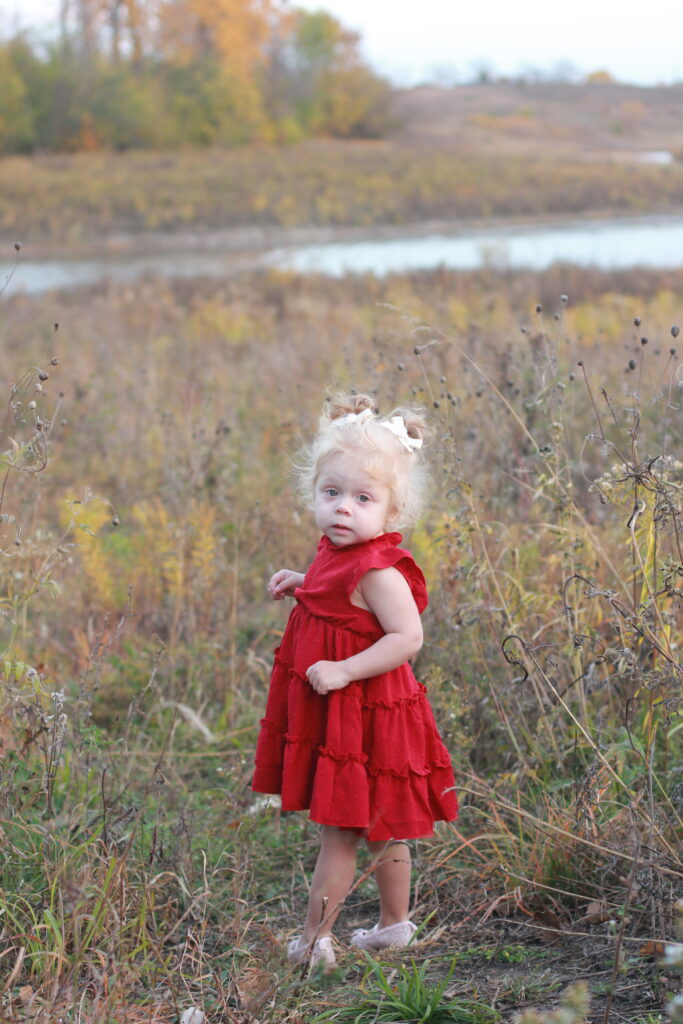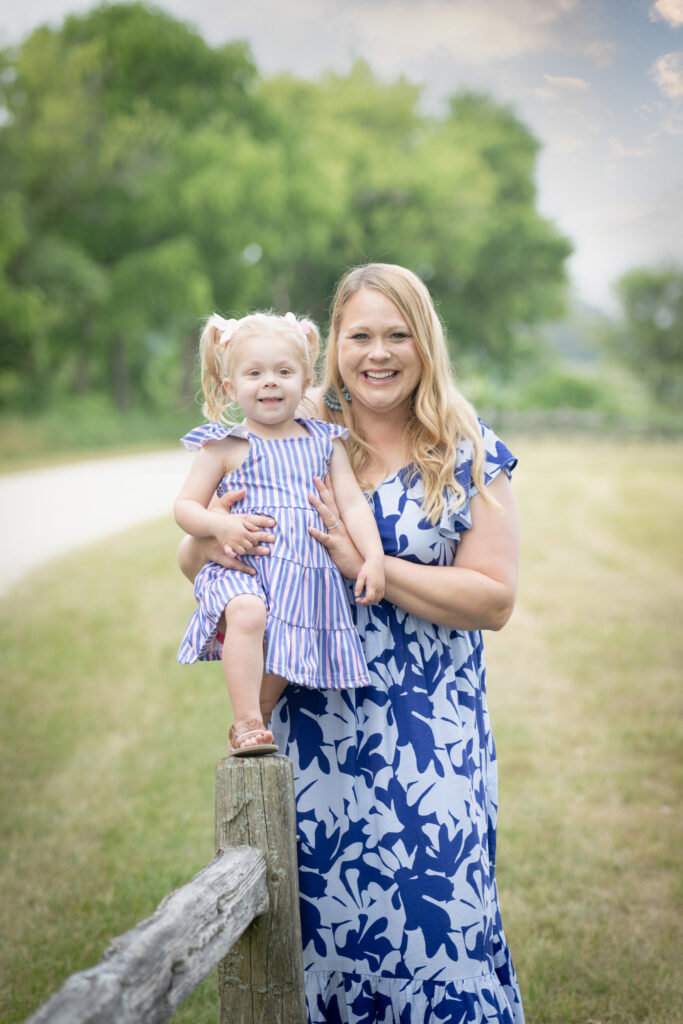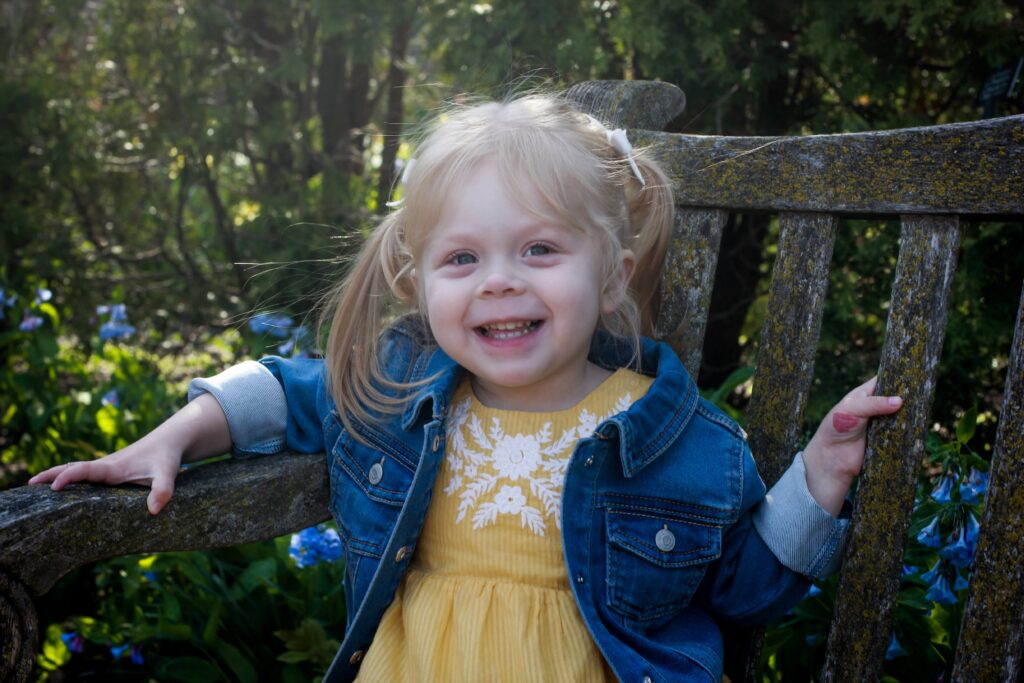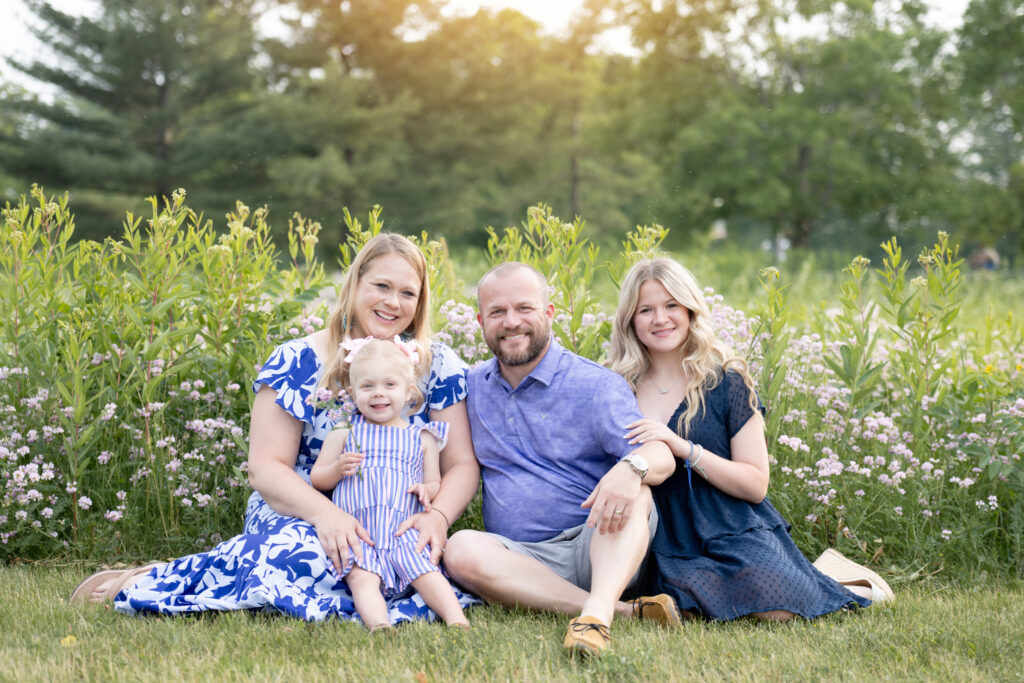
October 1, 2024 — October is Liver Awareness Month, which is the month touted by the American Liver Foundation to raise public awareness of the importance of liver health. More than 30 million Americans, or one in 10 Americans, suffer with some form of liver disease. This October, a Midwest transplant family is celebrating their daughter’s now healthy liver and is extremely grateful for the family who donated their child’s organ to save her life.
Nicole and Wade Wrobel of Arlington Heights, Illinois, were excited to learn they were expecting a baby. They were a little concerned, however, when Savanna arrived early in June 2020 at 35 weeks and three days. Due to her premature birth, Savanna was taken from her parents’ arms and transported to the Neonatal Intensive Care Unit (NICU) at Northwest Community Hospital in the Chicago suburbs. After several days in the NICU, the doctors noticed Baby Savanna’s bilirubin levels were not decreasing. Nicole and Wade vaguely remember hearing there was a possibility of a pediatric liver disease and potentially a liver transplant, but those were seemingly dismissed because they seemed unlikely at that time.
Savanna spent almost a week at Northwest Community Hospital before she was transferred to Ann and Robert H. Lurie Children’s Hospital of Chicago – in the heart of the city – for further testing and consultation. At Lurie Children’s many tests were run, including a liver biopsy, to start assessing the next steps. On July 17, 2020, at less than a month old, Savanna underwent a surgical study called a cholangiogram. The cholangiogram is performed to confirm the diagnosis of Biliary Atresia (BA). To perform a cholangiogram, the surgeon places a small tube into the gall bladder, if present. Then a medication is injected to help find the bile ducts using an X-ray machine. If the gall bladder and bile ducts are not open and bile cannot drain, the child has BA. After this study, Savanna was diagnosed with Biliary Atresia and the surgeon informed Nicole and Wade they would start the Kasai procedure.

During the Kasai, the surgeon removed the abnormal bile dusts where they connect with the liver. A piece of small intestine called the jejunum was then used to replace the bile ducts, making a connection between the liver and the intestine. This connection hopefully re-establishes bile drainage into the intestine and would possibly prolong the use of her native liver. “Finally, a week later on July 25th, and a month since she had been born, we were able to bring our beautiful baby girl home for the first time. But we were told there could be ‘No Visitors’ due to COVID-19 pandemic restrictions,” Nicole said.
Nicole and Wade returned to their home knowing that in approximately three months, it would be apparent whether or not the Kasai was a ‘success.’ While the wait was stressful, they were thrilled to have Savanna at home and to not be living in a hospital. Unfortunately, blood work taken several weeks later showed the Kasai was unsuccessful. They remember how frightening it was to hear the medical team tell them Savanna would need a liver transplant prior to her second birthday. The team at Lurie told Nicole and Wade that as long as Savanna was not experiencing complications, they would continue to monitor her but wanted the baby to stay at home to grow as much as possible prior to her inevitable transplant.
During these months of waiting, Nicole was doing as much research as possible regarding the journey they would be travelling with Savanna. Nicole joined a Facebook liver support group where she connected with many parents whose children had already travelled this road. She developed a strong connection with another Chicago-area family whose daughter had the same BA diagnosis and had already received her liver transplant. This family highly recommended Nicole reach out to the Children’s Organ Transplant Association (COTA) to see if they might be able to help with some of the family’s financial fears and stressors related to a liver transplant.
On May 24, 2021, Nicole called and talked to COTA’s Family Outreach Specialist. Nicole was able to ask specific questions about their family’s potential transplant-related expenses including co-pays, deductibles and insurance premiums, but also wondered about the special formula Savanna had to drink along with costly vitamins and supplements. Nicole said they lived about 33 miles from the transplant center, and they were already spending quite a bit of money on travel, meals and Chicago parking. There was also a question about potential unpaid leave at the time of transplant for at least one parent.

The Children’s Organ Transplant Association uniquely understands that parents who care for a child or young adult before, during and after a life-saving transplant have enough to deal with; therefore, COTA’s model shifts the responsibility for fundraising to a team of trained volunteers. COTA is a 501(c)3 charity so all contributions are tax deductible to the fullest extent of the law, and funds are available for a lifetime of transplant-related expenses. On June 7, 2021, Nicole and Wade completed and sent their signed agreement to COTA’s headquarters … the Wrobel family officially became part of the COTA Family, and Savanna became a COTA Kid. Nicole remembers thinking they were ahead of the game and still had plenty of time to start planning for fundraising for transplant-related expenses, but exactly one month later Savanna was listed for a liver transplant.
Savanna was able to spend almost an entire year at home with her parents. But on July 6, 2021, that changed. Savanna had been running a fever for about 24 hours when Nicole and Wade drove her to Lurie’s Emergency Room. Once there, the team discovered Savanna had an infection in her belly due to a fluid, called ascites, which is caused by cirrhosis of the liver and portal hypertension. The time had come for Savanna to be evaluated and listed for a liver transplant.
On July 16th, a COTA fundraising specialist trained the COTA for Savanna Strong volunteer team via phone due to the pandemic. After their specialized training, the Wrobels’ family and friends were ready to start raising funds for transplant-related expenses. They worked very hard to get fundraising events planned. Almost immediately, Nicole and Wade started posting Savanna updates on the COTA-provided fundraising website.
On July 27th, Nicole posted: “Today was Transplant Evaluation Day. I think the real test was on Mom and Dad. We had to sit through an entire day of meetings with the transplant coordinator, finance coordinator, medical doctors, the dietician and the surgical team where they explained everything that can possibly happen prior to, during and after transplant. We continue tomorrow with the pharmacist, infectious disease doctor and the social worker. It’s A LOT to hear all the things that could happen to our beautiful baby. When she is transplanted, she isn’t ‘cured,’ she is exchanging her deadly disease for another chronic condition with its own hurdles. It never goes away. We are both mentally and emotionally exhausted.”

On July 29th, Nicole posted on the COTA-provided website: “We are going home and we pray won’t need to come back for a while. Two hospital stays in one month, for one week each … is enough for us for now. Keep the prayers and good vibes coming.
A few days later the Wrobels were back at Lurie, this time because of potential microscopic bleeds. Savanna had to receive a blood transfusion and was prescribed new medications. She also required a five-day course of IV antibiotics as a precaution. Once listed for transplant, any infection would prevent Savanna from receiving a liver offer.
On August 4th, they posted: “Even though Savanna will be listed for transplant soon, this does not mean she will get a deceased donor quickly. The typical wait time is three months. We have looked at the list and there are currently 7 kids with Savanna’s blood type in line before her in our organ transplant region (Illinois, Wisconsin, Minnesota, North and South Dakota). This is why we are getting living liver donors evaluated ASAP to avoid waiting so long and Savanna getting sicker.”
On August 14th, they posted: “It’s so difficult for us when we’re taking Savanna to Lurie Children’s. Some people might think we are used to it, like going through the security line at the airport. But every time we get out of the car and put our infant daughter in her stroller to walk to the ER, she looks at us optimistically like we’re going on a normal walk. Perfectly trusting and content. Then she’s in the ER getting poked and prodded and attached to monitors with IVs and is crying. She doesn’t understand why we’re letting people hurt her. These are the most difficult times for us.”
On August 29, 2021, Savanna received her new liver and her second chance at life. The Wrobels said the surgery went well and she was stable throughout. The surgeons had some issues with her portal vein and were not able to connect all of the pieces of the liver during the transplant. Nicole and Wade were told she would need to go back to the operating room to have the bile duct connected and her abdomen closed. Because of these challenges, the team had just closed the skin around the area. The first post-transplant week was very challenging. Savanna was taken to the operating room several times for a variety of complications due to the size of her transplanted liver. To relieve some pressure, the team had to remove half of Savanna’s pancreas to create space and allow the portal vein to flow. But even with that, there were concerns. On August 31st, they were able to finally share with their Savanna Strong followers, “Her liver numbers seem better. Her portal vein has flow, and she was stable overnight.”

On September 2nd, Nicole posted: “In spite of all the conversations with doctors, reading and preparations for this process, we could never have imagined so much would happen on a daily basis. Hopefully, this morning will be her last surgery. Her liver bile ducts are being reconnected and the tissue expander removed. She is having a temporary dialysis catheter inserted into her neck to help support her kidneys and drain fluid. It’s overwhelming to think about everything she is going through. It’s been a rollercoaster these few days, one thing seems better and then something seems worse. It’s been really hard on me and Wade.”
On September 6th, Nicole posted: “Day 8 in the PICU. Her liver numbers are trending in the right direction. We want to thank everyone for being here with us on our journey. We can’t thank you enough for assisting us and affording us the opportunity to be here by her side. They told us that through everything that’s going on, she can hear us. So, we talk to her, read her books, play music, etc. We believe being here each day is helping her heal.”
Savanna had to be put back on dialysis. She was starting to make urine, but her kidneys could not keep up. The team told Nicole and Wade the plan was to take her back to surgery the next week for the final close. Nicole and Wade were starting to feel like Savanna was going to be in the PICU for a very long time.
On September 10th, Wade posted: “Savanna had a short paralytic ‘holiday’ today and it was her best one yet! She opened her eyes wide and looked at me and Nicole for a few minutes and squeezed her little Minnie Mouse doll. They had to put her back on sedation relatively quick because she was starting to move her head and shoulders and they didn’t want her to damage the dialysis in her neck. It’s hard to explain the excitement of seeing her beautiful eyes open wide again, even for a few minutes. It was almost like the day she was born … it was like medicine for me and Nicole.”
Nicole and Wade continued to post during the weeks of being inpatient to keep their followers updated about Savanna’s complicated transplant recovery. When their friends and family members would reach out and leave messages of support, it was also ‘like medicine’ for the weary couple who rarely left their baby’s bedside.
On October 25th, they posted: “Day 46 LAST DAY in the PICU. We are moving to a normal GI floor. No dialysis today because she is peeing! She was able to sit on the playmat on the floor with some toys, did some standing and got Mommy and Daddy snuggles! Just keep swimming…”

On November 12th, they posted: “Day 75 is Savanna’s Homecoming Day. On her 75th day in the hospital, we are going home. We hope you can help and donate $0.75 or $7.50 or $75.00 to COTA for Savanna Strong. Every contribution makes a big impact!
On March 24, 2022: “Today Savanna is 21 months old and we are so humbled that the $80,000 COTA for Savanna Strong goal has been surpassed! There are many days we are beaten down and don’t want to schedule one more appointment or go to one more blood draw, talk to one more billing agent, refill one more med, clean one more bucket full of oral syringes, but it’s ALL OF YOU who continue to warm our hearts and keep us going. COTA’s support is for a lifetime, and for that we will be forever grateful. One day, Savanna will understand what a great village she has lifting her up.”
Savanna’s transplant journey continued to have periodic bumps in the road throughout 2022. The Wrobels also continued to have a multitude of appointments, tests, lab work and many more costly transplant needs for Savanna. Since hearing the diagnosis, Wade and Nicole appreciate every moment … every milestone … they have with their beautiful, bright-eyed, high-energy little girl. They also continue to be extremely appreciative of COTA.
“COTA provided a great platform and framework for the fundraising effort in honor of Savanna prior to and during our lengthy transplant stay,” Nicole said. “Since Savanna’s liver transplant, COTA has been great to work with regarding seemingly endless bills, prescription medications, trips to Lurie Children’s. I don’t know what we would have done without COTA.”
Today, Savanna is a rambunctious four-year-old who is thriving. She is followed by liver, kidney and cardiology specialists at Lurie Children’s. She takes three medications (twice daily) and various vitamins in an effort to keep her strong and healthy post-transplant. The Wrobels say they are blessed to live in a city where they have access to some of the best pediatric liver specialists and transplant surgeons in the world. They are beyond thankful for the support of their family, friends and colleagues.

“Having an organization like COTA as part of our journey changed our life,” Nicole said. “They gave us hope that we could continue on after Savanna’s transplant and not be trapped in years of medical debt. Dedicating 100% of your time and energy to a sick child is extremely hard, and figuring out a way to pay for it adds so much weight and stress. COTA helped us find relief and breathe easier so we could focus on what was most important — our daughter.”
Nicole and Wade know transplant is not a cure. It provides a much better quality of life, but requires costly medications, treatments and monitoring. COTA exists to help families, like the Wrobels, navigate their transplant journeys … for a lifetime.
Savanna’s huge smile brightens every room she enters. She loves The Little Mermaid, unicorns, sharks, dolphins, dinosaurs, coloring, making puzzles, bath time and eating … bread, cake, dates and cheese (and more cheese). Savanna also climbs and slides on any playground she sees. Her new liver is working well, and her parents are extremely grateful for the family who unselfishly chose organ donation during a time of loss and sadness. Thanks to that gift of life, Savanna, is able to exude joy.
October is Liver Awareness Month. This month recognizes the importance of liver health and the causes of liver disease. A healthy liver serves many vital functions, including breaking down, balancing and creating nutrients from food, storing energy, cleaning the blood, regulating blood clotting and fighting infections. There are more than 100 different liver diseases caused by viruses, genetics, autoimmune disease, excessive alcohol use, poor diet and obesity and reactions to medications, street drugs, or toxic chemicals. Many people with liver disease do not look or feel sick and are unaware that damage is occurring. Symptoms of liver disease can include nausea or vomiting, abdominal pain, fatigue, yellow-colored skin and eyes, dark urine and weight loss; however, symptoms can vary depending on the specific disease or cause of damage.


